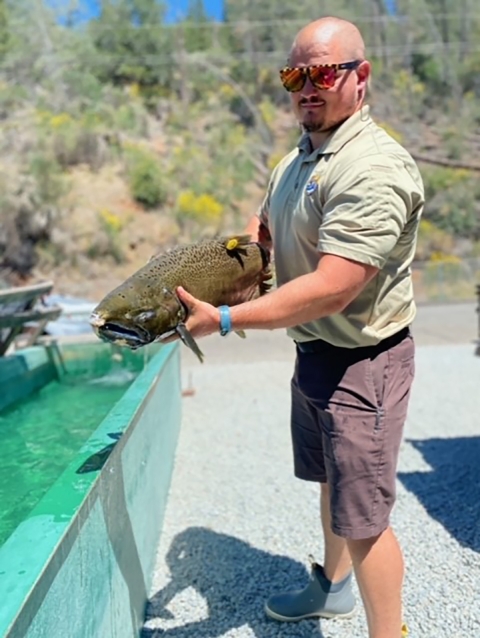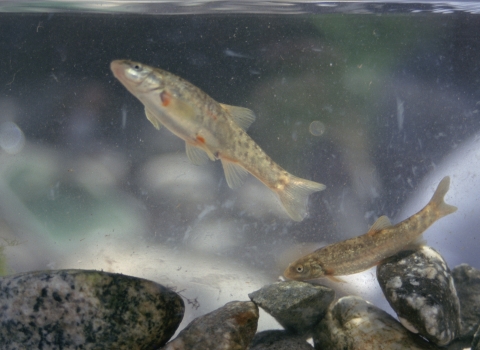REDDING, Calif. – The Bureau of Reclamation and U.S. Fish & Wildlife Service are partnering to protect winter-run Chinook salmon in a crucial year of their life cycle at the Livingston Stone National Fish Hatchery and third consecutive drought year in California.
The Service operates the hatchery while Reclamation provides water, power, and funding to support operations and maintenance of the facility. Behind the scenes, water managers, fish biologists, and project managers from Reclamation and the Service have been working together to best meet critical water needs anticipated during this unprecedented drought.
During years of average or greater precipitation, water quality at LSNFH is generally suitable for salmon production. However, as water temperatures from Shasta Lake are expected to be elevated this year due to the lake’s low level, Reclamation and the Service have installed several temporary water chilling units to cool and stabilize the water supply to the hatchery.
“We are pleased to work with our federal partners in this third year of unprecedented drought to benefit winter-run Chinook salmon at this stage of their life cycle,” said Reclamation Regional Director Ernest Conant. “Implementing this unique strategy at this critical time is essential to their survival.”
"Winter-run Chinook salmon are particularly vulnerable to drought and warming water temperatures, which are expected to continue this year in California,” said Paul Souza, Regional Director for the Service’s Pacific Southwest Region. “Our hatchery staff and Reclamation are working together to develop immediate and innovative solutions, like the use of chillers, to help this fish survive into the future despite current challenges," he added.
This third year of extreme drought coincides with the three-year life cycle of winter-run Chinook salmon. Poor survival during the last two drought years makes this a critical year for the population’s survival. In each of the preceding drought years, poor conditions have led to elevated temperature-related mortality in early life stages of these fish in the Sacramento River.
With the help of these chillers, the hatchery will continue to provide a critical safety net for winter-run Chinook salmon while in-river conditions remain poor. As water temperatures must be maintained below 56 degrees Fahrenheit for successful winter-run reproduction, the chilling units will cool the hatchery’s water supply up to 20 degrees at 3,000 gallons per minute. Since water supply to the hatchery is pulled directly from Shasta Dam, there are complex interactions between the water temperatures in the hatchery and dam operations. Technicians are on site monitoring the chilling units 24-hours a day in order to ensure success.
The contract to install, maintain, and monitor the chilling units was awarded to Montcal, LLC, a joint venture Native American (American Indian) and economically disadvantaged woman owned small business.
SNFH was initially constructed in 1997 as a conservation and rearing facility for the Endangered Species Act-listed winter-run Chinook salmon after years of population decline. Located directly below Shasta Dam on the banks of the Sacramento River, the location of the hatchery is ideally located to promote winter-run Chinook salmon, downstream of where historic winter-run spawning habitats were located.
For more information, including interviews and photo album, visit: https://www.usbr.gov/mp/ncao/lsnfhwc.html and https://www.fws.gov/fish-hatchery/livingston-stone.
Contacts:
Mary Lee Knecht, Reclamation, 916-978-5100, mknecht@usbr.gov
John Heil, U.S. Fish & Wildlife Service, 916-414-6636, john_heil@fws.gov
The Bureau of Reclamation is a federal agency under the U.S. Department of the Interior and is the nation's largest wholesale water supplier and second largest producer of hydroelectric power. Its facilities also provide substantial flood control, recreation opportunities, and environmental benefits. Visit www.usbr.gov and follow @USBR & @ReclamationCVP on Twitter; Facebook @bureau.of.reclamation; LinkedIn @Bureau of Reclamation; Instagram @bureau_of_reclamation; and YouTube @reclamation.
The U.S. Fish and Wildlife Service works with others to conserve, protect, and enhance fish, wildlife, plants, and their habitats for the continuing benefit of the American people. For more information about our work and the people who make it happen, visit https://www.fws.gov/cno/ or connect with us via Facebook, Twitter, YouTube and Flickr.




